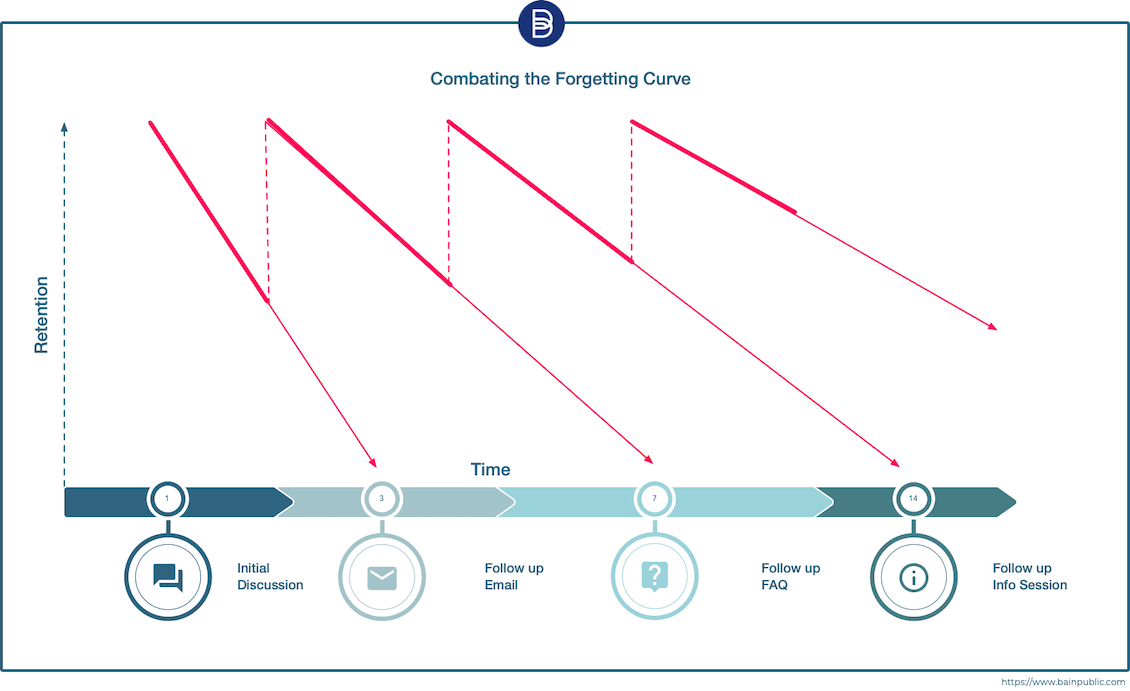Editor’s note: This article originally appeared on the Bain Public blog.
The first and paramount responsibility of a product manager is the difficult task of building a shared understanding of the product strategy through listening, influencing, and repeating. While half of your time should be spent on the creation and management of the product strategy, another portion must be devoted to repeating it. State it to team members, and say it again to the CEO. This is how the product will benefit the organization.
But what happens when you stop repeating and communicating the product vision and strategy? This is where the forgetting curve can set in.
The forgetting curve
Originating in the 19th century and founded by German psychologist Hermann Ebbinghaus, the forgetting curve looks at how quickly something is forgotten soon after it is learned. In fact, only 25% of the information that has been repeated once will remain in your memory after the first hour. This is why repeating your product strategy often leads to better recall later on and prevents any misalignment in the future.
The graphs below show the process of how forgetting occurs. According to this research, people tend to forget information rather quickly, most often within the first hour. The more often information is repeated, the higher percentage of memory retention.
While the speed of forgetting information can depend on a number of factors, the best way to increase the strength of memory is through repetition at regular intervals, also known as “spaced repetition.”
According to Ebbinghaus, the forgetting curve flattens with every repetition and reduces the forgetting process.
“Repetition is the mother of learning, the father of action, which makes it the architect of accomplishment.” Zig Ziglar
Repeat and communicate the product vision
To prevent the forgetting curve from setting in, as the product manager, you’re the CRO (Chief Repeating officer) and need to communicate what should go in a product and how to market and sell it any chance you get. Ebbinghaus discovered that people tend to remember things better when they can visualize it. For this reason, a good trick to ion and constant grooming of a one-page intermission document for a set of proposed features.
What should this document include?
- Start with a hypothesis
- Create a “tweet-able” value proposition
- Create a list of five to ten bullet points stating the problems to be solved (this should be straightforward because you’ve studied the market and competitive landscape, and understand your prospective buyers and users)
- Include a “why the project is valuable” paragraph which describes the problem or opportunity (this is a discourse centered around the customer, the problems they face, and how your solutions will solve it
- Write three to give business drivers and what the initiative will try to accomplish over the next three to twelve months. Next, give it strategic importance, which can be one of the following:
- New revenue: new income projected to be generated
- Incremental revenue: additional income from existing customers coming from charging for upgrades or other services
- Retained revenue: income that isn’t lost because customer churn is reduced through reliability, usability or functionality improvements
- Cost savings: any operational efficiency gained inside the company
- Leverage assets: transformational idea for future growth or profit
- Finish the document by bullet pointing any success criteria (these key performance indicators stem from your in-depth knowledge of the current product metrics and should be expressed as clear targets)
Manage expectations through “per unit” repetition
With an intermission document in hand, you can find opportunities to improve internal communications. Recognize that your up-front hypothesis requires a sounding board for adjustments. So go ahead and find time to meet with everyone individually. Repeat your strategy, give them the information they need, and fine-tune. Repetition promotes alignment among diverse groups within your organization, clarifies objectives and priorities, and helps focus efforts around them.
“A day or two after attending a roadmap prioritization meeting or reading a follow-up email, stakeholders will have forgotten approximately 75% of what was communicated” Paul Ortchanian, CEO, Bain Public
Make an opportunity assessment for proposed features. Start by explaining your strategy, then listen to what your colleagues have to say. Interface with team members daily and meet with everyone individually. Use those opportunities to repeat bits and pieces and make corrections along the way. Allow for further questions and discussions. This is a good chance to identify and manage any “grenades.” These are known as influential individuals who aren’t necessarily aligned with upcoming features and have a strong say in the evolution of the product.
The forgetting curve flattens with each repetition
Communicate the product roadmap by cutting and pasting various sections of the document and sending them as an email to customers (i.e. product updates), executives (i.e. product summary), and company resources (i.e. product broadcast). Discuss the problems the product should solve with your product council and customers to calibrate.
- Each repetition reduces the forgetting process and the need for extra repetition
- People remember things better when they can visualize, or relate to it
- Asking questions that require information recall solidifies the memory
At each step, highlight elements from your document and use its content to repeat tirelessly. Do team members and the CEO understand how the product will benefit the organization? If not, stay persistent and repeat.
Fulfill your vision
You are in charge of mapping out the steps that your team is going to take to fulfill your product roadmap. Impose structure on your work by relentlessly repeating the content of this single document. Make the learning process more interactive. This disciplined approach stops you from worrying. It puts an end to disorienting schedules and frees your time to communicate the product roadmap strategy.

![[object Object]](https://cdn.builder.io/api/v1/image/assets%2F6a96e08774184353b3aa88032e406411%2F39f3ccde352b460cbf348ccc952054cd?format=webp)



